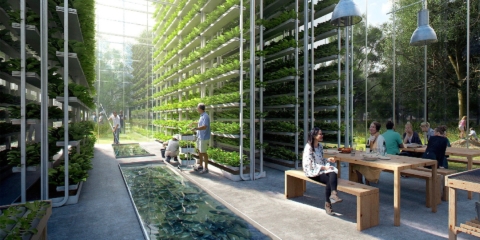Would you like to get notifications from Christian?
Solar panels often get a bad rap for spoiling the appearance of homes and businesses. Yet, this may be about to change. A research group has fabricated a highly transparent solar cell with a 2D atomic sheet. These near-invisible solar cells achieved an average visible transparency of 79%, meaning they can, in theory, be placed everywhere - building windows, the front panel of cars, and even human skin. Scientists have long sought to develop transparent solar cells, but the suitable materials have not existed thus far.
We could see a future where solar panels are no longer an eyesore, but instead are integrated into our everyday lives in a way that is both aesthetically pleasing and environmentally friendly. What's more, this technology has the potential to increase the power conversion efficiency of solar cells by up to 1000x. This could finally make solar power a viable alternative to traditional forms of energy generation such as coal and oil.
Highly transparent solar cells have a 1000x greater power conversion efficiency. Solar panels often get a bad rap for spoiling the appearance of homes and businesses. Yet, this may be about to change. A research group has fabricated a highly transparent solar cell with a 2D atomic sheet. These near-invisible solar cells achieved average visible transparency of 79%, meaning they can, in theory, be placed everywhere - building windows, the front panel of cars, and even on human skin. Scientists have long sought to develop transparent solar cells, but suitable materials have not existed thus far.

The implications of this technology are immense. We could see a future where solar panels are no longer an eyesore but instead are integrated into our everyday lives in a way that is both aesthetically pleasing and environmentally friendly. What's more, this technology has the potential to increase the power conversion efficiency of solar cells by up to 1000x. This could finally make solar power a viable alternative to traditional forms of energy generation, such as coal and oil.
Policymakers should see this new technology as evidence that investing in renewable energy is worthwhile; businesses should begin looking into how they can integrate solar panels into their products; individuals should be inspired to demand more renewable energy options from their government representatives. This new development represents a significant breakthrough in renewable energy technology. For too long, renewables have been considered inferior to fossil fuels in generating electricity. This new development could change all that. If we can find a way to mass-produce these transparent solar cells, we could finally see renewables overtake fossil fuels as our primary energy source.
There are many applications for this new technology beyond simply generating electricity. The military has already expressed interest in using these types of cells to power vehicles and equipment that need to be camouflaged. This new development is yet another reminder that we need to continue investing in renewable energy to secure our environmental future.
The future is bright for solar power! With this new development in transparent solar cells, we have the potential to increase power conversion efficiency by up to 1000x! This means we could finally make solar power a viable alternative to traditional forms of energy generation, such as coal and oil! Moreover, this technology has many applications beyond electricity generation - including camouflage for military vehicles! We need to continue investing in renewable energy if we want secure our environmental future!
Author: Christian Kromme
First Appeared On: Disruptive Inspiration Daily
Christian is a futurist and trendwatcher who speaks about the impact of exponential technologies like AI on organizations, people, and talents. Christian tailors his presentations to your audience's specific industries and needs.



Our world is changing at an exponential rate! A big tidal wave of digital transformation and disruption is coming at us fast. Many organizations see this wave as a threat and experience stress, but there are also organizations that just see this wave as an opportunity.

Imagine sitting with just 10-15 fellow executives at a premier location, gaining clarity on the impact of AI on your industry while enjoying an exquisite dining experience. These are not just meetings—they are transformative moments that will shape the future of your organization



In the future, 3D printing and generative design will allow for products to be designed in a more decentralized manner, and production will take place closer to the customer and fully on-demand. 3D printing technology will also allow for more customization and personalization of products.


The agricultural industry is ripe for disruption. Robotics, AI, and IoT are all technologies that have the potential to radically transform the way we grow food. In combination with vertical farming, these technologies could increase the efficiency and quality of agricultural products.

A human-centered society is one that puts people first and where technology is used to unite and empower people. It is a society that values biological life and dignity above all else. It is a society that recognizes the importance of human relationships and works to strengthen them. In a human-centered society, all members of the community are valued and treated with respect.


The future of healthcare is here. New technologies like AI, IoT, big data, and smart sensors make it possible to become the CEO of your own health. Imagine that your phone can listen to your voice and AI algorithms can detect small nuances in the tone of your voice that indicate specific diseases.
